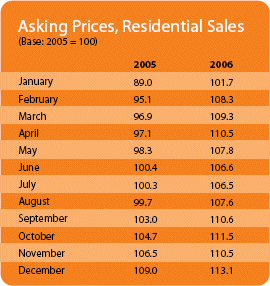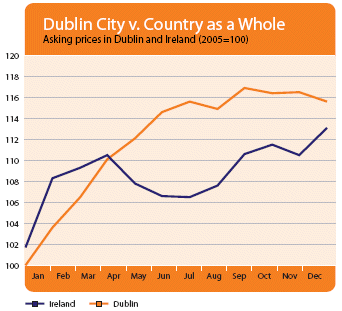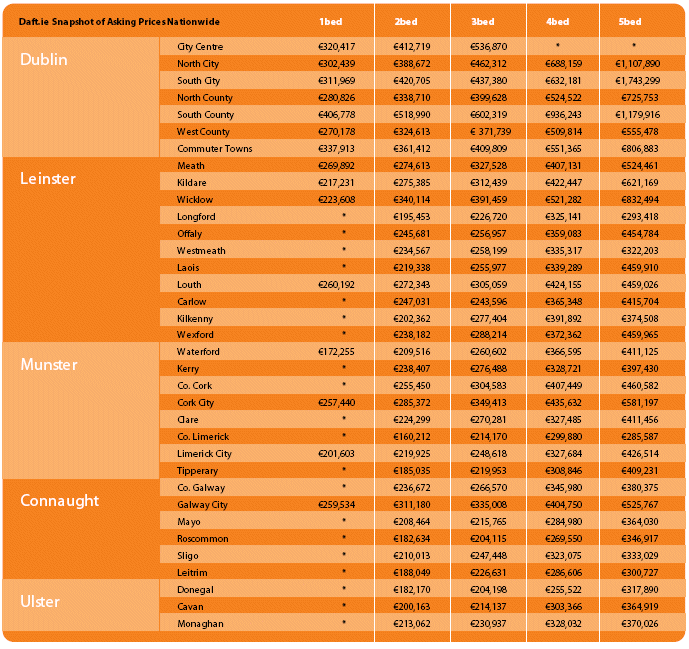Big Regional Variations in More Realistic Property Market
Daft Reports
- Ronan Lyons (House Price, Q1 2024)
- Ronan Lyons (Rental Price, Q4 2023)
- Ronan Lyons (House Price, Q4 2023)
- Ronan Lyons (Rental Price, Q3 2023)
- Ronan Lyons (House Price, Q3 2023)
- Ronan Lyons (Rental Price, Q2 2023)
- Ronan Lyons (House Price, Q2 2023)
- Ronan Lyons (Rental Price, Q1 2023)
- Ronan Lyons (House Price, Q1 2023)
- Ronan Lyons (Rental Price, Q4 2022)
- Ronan Lyons (House Price, Q4 2022)
- Ronan Lyons (Rental Price, Q3 2022)
- Ronan Lyons (House Price, Q3 2022)
- Ronan Lyons (Rental Price, Q2 2022)
- Ronan Lyons (House Price, Q2 2022)
- Ronan Lyons (Rental Price, Q1 2022)
- Ronan Lyons (House Price, Q1 2022)
- Ronan Lyons (Rental, Q4 2021)
- Ronan Lyons (House Price, Q4 2021)
- Ronan Lyons (Rental, Q3 2021)
- Ronan Lyons (House Price, Q3 2021)
- Ronan Lyons (Rental, Q2 2021)
- Ronan Lyons (House Price, Q2 2021)
- Ronan Lyons (Rental, Q1 2021)
- Ronan Lyons (House Price, Q1 2021)
- Ronan Lyons (Rental, Q4 2020)
- Ronan Lyons (House Price, Q4 2020)
- Ronan Lyons (Wealth, H2 2020)
- Ronan Lyons (Rental, Q3 2020)
- Ronan Lyons (House Price, Q3 2020)
- Ronan Lyons (Housing, July 2020)
- Ronan Lyons (Housing, June 2020)
- Ronan Lyons (Housing, May 2020)
- Ronan Lyons (Rental, Q1 2020)
- Ronan Lyons (House Price, Q1 2020)
- Ronan Lyons (Rental, Q4 2019)
- Ronan Lyons (House Price, Q4 2019)
- Ronan Lyons (Wealth, H2 2019)
- Ronan Lyons (Rental, Q3 2019)
- Ronan Lyons (House Price, Q3 2019)
- Pierre Yimbog (Rental, Q2 2019)
- Ronan Lyons (House Price, Q2 2019)
- Ronan Lyons (Wealth, H1 2019)
- Ronan Lyons (Rental, Q1 2019)
- Ronan Lyons (House Price, Q1 2019)
- Ronan Lyons (Rental, Q4 2018)
- Ronan Lyons (House Price, Q4 2018)
- Ronan Lyons (Wealth, H2 2018)
- Ronan Lyons (Rental, Q3 2018)
- Ronan Lyons (House Price, Q3 2018)
- Shane De Rís (Rental, Q2 2018)
- Ronan Lyons (House Price, Q2 2018)
- Ronan Lyons (Wealth, 2018)
- Ronan Lyons (Rental, Q1 2018)
- Ronan Lyons (House Price, Q1 2018)
- Ronan Lyons (Rental, Q4 2017)
- Ronan Lyons (House Price, Q4 2017)
- Ronan Lyons (Rental, Q3 2017)
- Ronan Lyons (House Price, Q3 2017)
- Katie Ascough (Rental, Q2 2017)
- Ronan Lyons (Wealth, 2017)
- Ronan Lyons (House Price, Q2 2017)
- Ronan Lyons (Rental, Q1 2017)
- Ronan Lyons (House Price, Q1 2017)
- Ronan Lyons (Rental, Q4 2016)
- Ronan Lyons (House Price, Q4 2016)
- Ronan Lyons (Rental, Q3 2016)
- Ronan Lyons (House Price, Q3 2016)
- Ronan Lyons (School Report, 2016)
- Conor Viscardi (Rental, Q2 2016)
- Ronan Lyons (Rail Report, 2016)
- Ronan Lyons (House Price, Q2 2016)
- Ronan Lyons (Rental, Q1 2016)
- Ronan Lyons (House Price, Q1 2016)
- Ronan Lyons (Rental, Q4 2015)
- Ronan Lyons (House Price, Q4 2015)
- Ronan Lyons (Rental, Q3 2015)
- Ronan Lyons (House Price, Q3 2015)
- Marcus O'Halloran (Rental, Q2 2015)
- Ronan Lyons (House Price, Q2 2015)
- Ronan Lyons (Rental, Q1 2015)
- Ronan Lyons (House Price, Q1 2015)
- Ronan Lyons (Rental, Q4 2014)
- Ronan Lyons (House Price, Q4 2014)
- Ronan Lyons (Rental, Q3 2014)
- Ronan Lyons (House Price, Q3 2014)
- Domhnall McGlacken-Byrne (Rental, Q2 2014)
- Ronan Lyons (House Price, Q2 2014)
- Ronan Lyons (Rental, Q1 2014)
- Ronan Lyons (House Price, Q1 2014)
- Ronan Lyons (Rental, Q4 2013)
- Ronan Lyons (House Price, Q4 2013)
- Ronan Lyons (Rental, Q3 2013)
- Ronan Lyons (House Price, Q3 2013)
- Ronan Lyons (Rental, Q2 2013)
- Ronan Lyons (House Price, Q2 2013)
- Ronan Lyons (Rental, Q1 2013)
- Ronan Lyons (House Price, Q1 2013)
- Ronan Lyons (Rental, Q4 2012)
- Ronan Lyons (House Price, Q4 2012)
- Lorcan Sirr (Rental, Q3 2012)
- Padraic Kenna (House Price, Q3 2012)
- John Logue (Rental, Q2 2012)
- Ronan Lyons (House Price, Q2 2012)
- Barry O'Leary (Rental, Q1 2012)
- Seamus Coffey (House Price, Q1 2012)
- Joan Burton (Rental, Q4 2011)
- Ronan Lyons (House Price, Q4 2011)
- Philip O'Sullivan (Rental, Q3 2011)
- Sheila O'Flanagan (House Price, Q3 2011)
- Rachel Breslin (Rental, Q2 2011)
- Constantin Gurdgiev (House Price, Q2 2011)
- Cormac Lucey (Rental, Q1 2011)
- Eoin Fahy (House Price, Q1 2011)
- Lorcan Roche Kelly (Rental, Q4 2010)
- Ronan Lyons (House Price, Q4 2010)
- John Fitzgerald (Rental, Q3 2010)
- Patrick Koucheravy (House Price, Q3 2010)
- Gary Redmond (Rental, Q2 2010)
- Jim Power (House Price, Q2 2010)
- Jill Kerby (Rental, Q1 2010)
- Brian Lucey (House Price, Q1 2010)
- Michael Taft (Rental, Q4 2009)
- Alan McQuaid (House Price, Q4 2009)
- Dr. Charles J. Larkin (Rental, Q3 2009)
- Emer O'Siochru (House Price, Q3 2009)
- Ronan Lyons (Rental, Q2 2009)
- Oliver Gilvarry (House Price, Q2 2009)
- Brian Devine (Rental, Q1 2009)
- Dr. Liam Delaney (House Price, Q1 2009)
- Gerard O'Neill (Rental, Q4 2008)
- Ronan Lyons (House Price, Q4 2008)
- Dr. Stephen Kinsella (Rental, Q3 2008)
- Moore McDowell (House Price, Q3 2008)
- Shane Kelly (Rental, Q2 2008)
- Fergal O'Brien (House Price, Q2 2008)
- Eoin O'Sullivan (Rental, Q1 2008)
- Dermot O'Leary (House Price, Q1 2008)
- Dan O'Brien (Rental, Q4 2007)
- Frances Ruane (House Price, Q4 2007)
- John McCartney (Rental, Q3 2007)
- Ronnie O'Toole (House Price, Q3 2007)
- Ronan Lyons (Rental, Q2 2007)
- Constantin Gurdgiev (House Price, Q2 2007)
- Fintan McNamara (Rental, Q1 2007)
- Rossa White (House Price, Q1 2007)
- Geoff Tucker (Rental, Q4 2006)
- Damien Kiberd (House Price, Q4 2006)
- Pat McArdle (House Price, Q3 2006)
- Marc Coleman (House Price, Q2 2006)
- David Duffy (House Price, Q1 2006)
- Austin Hughes (House Price, Q4 2005)
- David McWilliams (House Price, Q2 2005)

1st Feb 2007
Damien Kiberd is our guest blogger, analysing the Quarter 4 2006 figures.
The fourth quarter of 2006 brought a fundamental- and downward- shift in house price expectations among both developers and sellers of individual homes, according to the latest Daft.ie Asking Price Index (API).
The Q4 results suggest that by December 2006 sellers' asking prices were just 3.8% higher than in December 2005, while for the quarter as a whole (Q4 2006 V Q4 2005) asking prices were up by just 4.7%.
The API is the property market's leading edge indicator of changes in sellers' expectations. Some 65,000 properties are detailed on the Daft.ie website at any one time, which allows Daft researchers to base their analyses on statistically significant and reliable sample sizes.
A pronounced flattening out of house prices in Dublin during the third and fourth quarters depressed the national trend in the API , but prices continued to grow outside the capital.
The causes of these trends are clear. In the second-hand market a series of spectacular prices achieved in Q1 2006 flushed out an unprecedented number of would-be sellers, leading to oversupply in Q3 and Q4. Houses not normally put to auction were also offered for sale and by the year end four-fifths of homes on offer is the salesrooms were being withdrawn unsold, leading to adverse psychological effects on the wider market for second-hand homes. The problem of oversupply was compounded by injudicious comments from a senior government minister which held out the prospect of stamp duty cuts in the December budget, thereby causing potential purchasers to delay completing transactions throughout Q3 and into Q4. No duty cuts were actually approved by Minister Cowen.
In the market for new houses and apartments, developers in the Greater Dublin area opted to "hold" asking prices in the second half in order to maintain market share and to ensure their own, and their banks', cash flow. After two years which saw the Daft.ie API rise by close to 25% in Greater Dublin, profits for builders remain strong even with a levelling off in the market.
Developers' expectations were trimmed by the realisation that many potential buyers had reached the limits of affordability: Half of all mortgages now extend to terms of 25, 30 or 35 years and beyond. They were also dampened by six successive increases in the European Central Bank base rate which rose to 3.5%, triggering a welter of negative media predictions concerning house prices.
Outside Dublin prices continued to grow in the second half, however, with evidence of supply shortages emerging particularly in Limerick and to a lesser extent in Cork. Daft.ie's data suggests that typical homes in the regional cities and in extended belt of Dublin's "commuter towns" are on average €100,000 dearer than they were in early 2005.
But with the capital gearing up for significant high rise development the appetite for some suburban locations may be on the wane. The Daft.ie API for the second half of 2006 showed a softening of the market in suburbs such as Santry (-4.5%), Clonee (-9.4%) and Maynooth (-8.8%). Very significant competition among developers, particularly in North and West County Dublin where new suburbs are under construction tilted the market balance in favour of buyers, with developers forced to offer "extras" such as top class kitchens, designer planned gardens and "neighbourhood/lifestyle concepts" in order to achieve sales.
Public transport infrastructure developments are also causing geographic variations in "sellability". In early 2006 apartments in Luas served Sandyford, for example, were snapped up. Reflecting this reality both Dublin City Council and Fingal are to impose special development levies along the route of the planned Metro North.
The Daft.ie API analysis suggest that for first time buyers in Greater Dublin the most attractive prices for starter homes can be found in Newcastle, Balbriggan, Mulhuddart and Cherry Orchard where prices are just above the government's stamp duty threshold of €317,500.
Looking into 2007, consensus estimates among economic forecasters and market participants predict the now cliched "soft landing" with prices expected to rise by about 5% across the country. Positive factors supporting prices include Mr. Cowen's decision to address the affordability issue for first time buyers by doubling mortgage interest relief (for them) in Budget 2007. Other positives include the flood of SSIA cash rebates which will peak in April 2007, the ongoing demograpic expansion with the labour force growing by 4% annually and overall population up by 2.5%, the raft of new mortgage deals coming on stream from the banks and the general strength of the global economy where all of the big economies are predicting solid growth.
Daft.ie's latest index suggests that a new realism has entered what was a frothy marketplace. The primary casualty of the shake-out may be the auction room with the vast majority of young buyers now testing the market on-line before approaching sellers, developers and estate agents to process a deal. But the underlying market realities do not point to a collapse in prices either in 2007 or beyond.
HIGHLIGHTS:

Daft Asking Price Index (API)

Dublin v Rest of Country
SNAPSHOT:

Average House Prices across Ireland in Q4 2006
